Héricourt to Fesches-le-Châtel
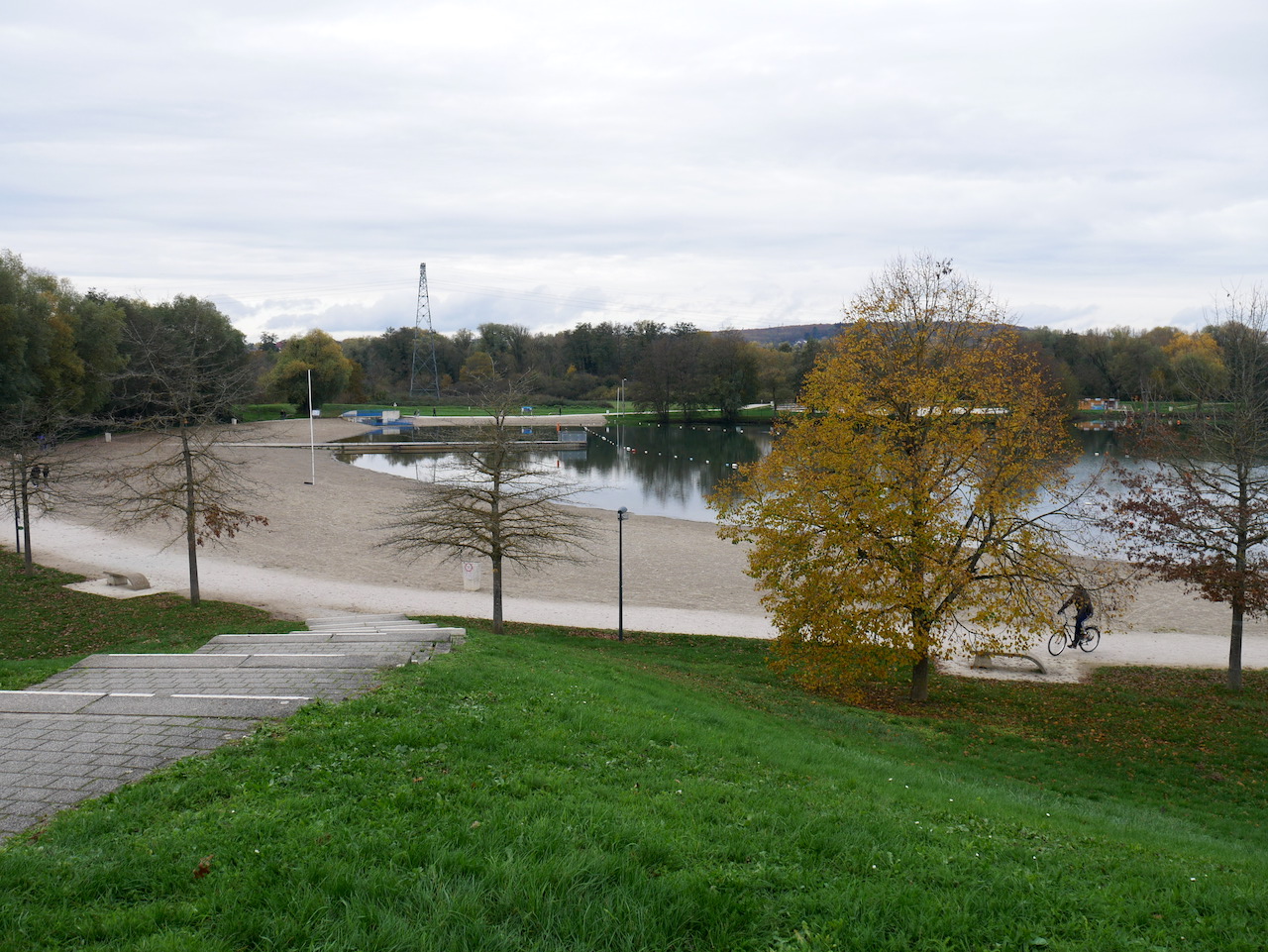
Bourgogne-Franche-Comté
3. Héricourt to Fesches-le-Châtel
Medium
5h30
20,5km
+298m
-310m
Step
Embed this item to access it offline
You start this stage by crossing the town of Héricourt and its heritage to continue in the forest. The towns of Châtenois-les-Forges and Nommay are easily crossed to reach the Water Leisure Centre. You continue along the Rhone-Rhine canal before reaching Fesches-le-Châtel.
10 points of interest
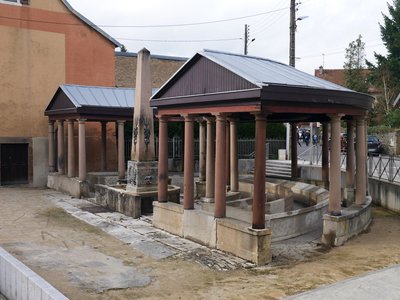
Le magnifique lavoir du Savourot à Héricourt - Amis saint Colomban TouristLavoir du Savourot in Héricourt
Located on Via Columbani, this hemicycle-shaped building is a work of the architects Mabille and Brissonnet built around 1840.
The semicircular wash-house basin is sheltered by a gable roof supported by 25 Tuscan columns resting on a peripheral low wall.
The sump (the fountain) occupies the centre of the circle. The basin, also in a semicircle, is fed by an obelisk that bears as ornaments, plants and the coat of arms of the city, made of cast iron.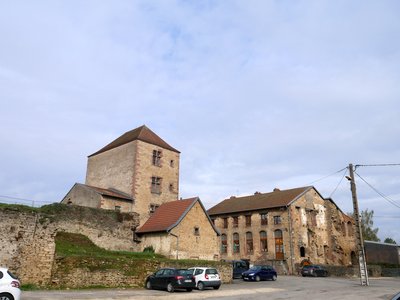
La tour féodale et les vestiges du rempart du château d’Héricourt - Amis saint Colomban HistoricalThe feudal castle of Héricourt
Historians agree to date the first castle during the 12th century because it is mentioned on a charter. This charter of 1374 was to bring peace and prosperity to the seigniory until the Reformation, when the Protestant Counts of Montbéliard opposed their Catholic neighbours at the court of Burgundy. The period of the Wars of Religion as well as enemy incursions impoverished the region.
The Versailles Convention of 1748 between the Duke of Württemberg and the King of France defined the rights and obligations of the four Lordships.
Of the old castle there remains a tower and a few walls which are the only witness of a rich past.
More info: Wikipedia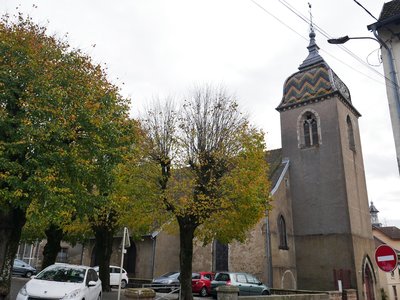
Le temple d’Héricourt - Amis saint Colomban TouristThe Protestant temple of Héricourt
The first parish church dates back to the 12th century, placed under the name of St. Christopher, it underwent several transformations in the 16th century with the addition of the choir and chapels. It is in the style of the churches of Franche-Comté with a Comtois bell tower, surmounted by a dome in the Imperial style, serving as the entrance.
In 1562 the Reformation transformed this Catholic church into a Lutheran church until the period of the "Simultaneum" of 1700 - 1887 which allowed the two cults to cohabit in the same building.
Go around the building to admire the tombstones of the seigneurial families of the 16th century.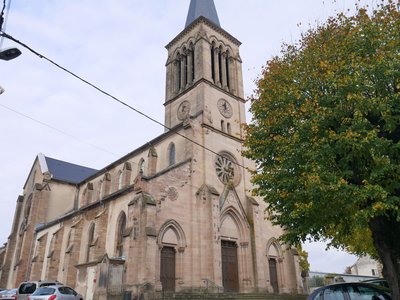
L’église catholique Saint-Christophe d’Héricourt - Amis saint Colomban TouristThe Catholic Church of St. Christopher in Héricourt
Completed in 1887, this building will bring together the Catholics in a new church opposite the Protestant temple which hosted the two services from 1700 to 1887 during the period of the "Simultaneum".
The church is more imposing than the temple. Inside you can admire the bell of 1516 which was in the bell tower of the temple and announced the services of the two religions. When the new church of St. Christopher was finished the parishioners of both communities decided to remove the bell from the temple bell tower and install it in the new Catholic bell tower. In 1976 a fire ravaged the bell tower and the bell fell cracking. It is the second oldest bell in Haute-Saône.
Observing the stained glass windows, the one dedicated to Saint Valbert de Luxeuil recalls the presence of the eponymous Priory.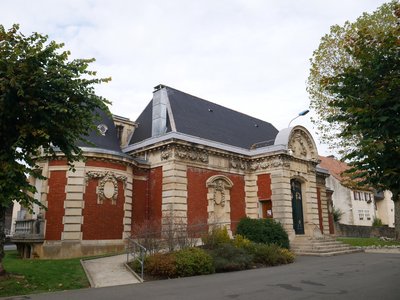
Le musée Charles Émile Minal au centre de la vieille ville. - Amis saint Colomban TouristThe Museum of Héricourt
The town of Héricourt has a museum with a particular architecture, which is extremely rare in the region and was originally designed to be a museum. Often these are installed in old buildings: castles, convents etc.. We can be grateful to Mr and Mrs Minal who made this possible.
Charles Emile Minal was born in Héricourt on 5 January 1817, he is the son of Pierre Frédéric Minal, a cretonne maker, and his wife Catherine Lods. He is the last of four children. Charles Emile left Héricourt for Paris around 1860, he was then a manufacturer at 30 Rue du Sentier. He was passionate about painting, and the museum owns about forty of his paintings, mainly caricatures.
Neo-classical style known as "brick and stone" and commonly known as Louis XIII, it has its origins in the 15th century, it combines the harmony of the warm colour of the brick and the whiteness of the stone added to the bluish grey of the slate roofs, nowhere else can this style be found in Europe.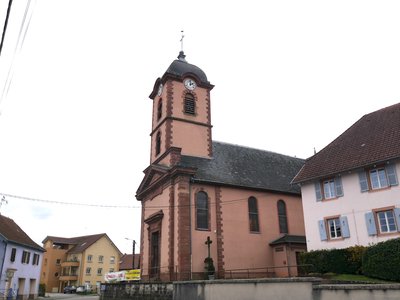
L’église Saint-Étienne de Fontenoy-les-Forges - Amis saint Colomban TouristThe church of Saint-Etienne de Châtenois les Forges
The name Châtenois was first mentioned in 1098. In 1147, Casteneyaco (Kestenholz in German) was then home to a priory of the order of Saint Augustine whose chapel would have served as a parish church. In 1300, a dispute between the prior of Châtenois and that of Lanthenans gave rise to a lawsuit which left traces in the archives. This religious establishment, which in 1435 had ceased to depend on the priory of Lanthenans to be attached to the chapter of Montbéliard, disappeared at the end of the 16th century. The present church was consecrated on 20 June 1745 to Saint Stephen.
In the 18th century, the iron and steel industry developed with the establishment of blast furnaces and forges for the treatment and processing of iron ore into grain, extracted in the region.
La plage de la base de Loisirs - Amis saint Colomban PanoramicLeisure Centre of the Montbéliard Region
If the weather and the weather permitting you can make a relaxing stop at this Leisure Centre. This old gravel pit as well as the ponds that you walked along before your arrival is intended for water sports and swimming.
With a bit of luck you will be able to attend a sporting event.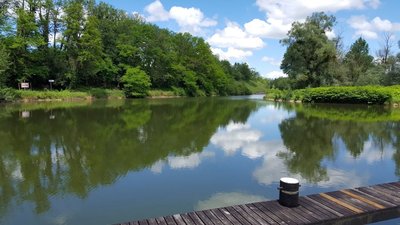
Le canal du Rhône au Rhin à l’écluse de l’Allan - Martine et René Michaux PanoramicThe Rhone-Rhine Canal
The Rhone-Rhine Canal connects the Saône, a navigable tributary of the Rhone, to the Rhine through the Doubs valley and its extension into Upper Alsace as far as Niffer on the Rhine.
Work on the junction between the Saône and the Doubs from Saint-Symphorien-sur-Saône in Côte-d'Or to Dole in the Jura was carried out with downtimes linked to the Revolution between 1784 and 1802.
The idea of linking the Rhone basin to the Rhine basin by waterways is an old one since Colbert and Vauban had mentioned it under Louis XIV after the annexation of Franche-Comté and Alsace, but it was in the 18th century that the project took shape.
In the middle of the 20th century a project to enlarge the canal to accommodate barges with a European gauge failed for political reasons. Germany took the opportunity to widen the Neckar Canal, a tributary of the Rhine, to the Danube; the North Sea is connected to the Black Sea and the Rhone Canal to the French Rhine is mainly used for pleasure boating.
Temple protestant de Fesches-le-Châtel - Amis saint Colomban TouristThe Protestant Temple of Fesches-le-Châtel
In the 19th century, the increase in population due to the industrial boom led to the construction of a new Protestant place of worship. In 1869, a temple was built according to the plans of the architect Fallot, in the centre of the old village. The building has a pink sandstone tower topped by a bell tower modified in 1905. The wide single rectangular nave ends in a three-sided chevet. The viraux are from the 20th century by the painter and engraver Olivier Calame.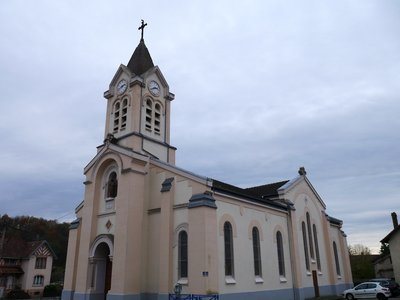
L’église Saint-Laurent à Fesches-le-Châtel - Amis saint Colomban TouristSt. Lawrence Church of Fesches-le-Châtel
In the 19th century, the town of Fesches-le-Châtel underwent an impressive industrial development, mainly oriented towards the manufacture of military tinned iron gamellerie, enamelled plates and wrought, tinned, enamelled or varnished iron kitchenware, which required significant recruitment of labour in the region but also abroad (Italians, Spaniards).
In 1963, the population was around 2,500 inhabitants. Construction continued with 7 new workers' housing estates, a church, a boarding house for young girls, a square, a new town hall and a new post office.
Modernism, wars and economic crises have overcome the manufacturing empire, which will close all its factories between 1981 and 1984.
Today a town of 2,310 inhabitants, in the midst of urban renewal, is part of the green and blue infrastructure of the Communauté d'Agglomération du Pays de Montbéliard.
Before 1919, the village's Catholic community was attached to the parish of Dampierre-les-Bois. In 1919, Abbot Henri Simon was appointed to Fesches-Le-Chatel. His mission was the creation of a parish grouping Fesches-Le-Chatel, Allenjoie and the 'La Truche' district of Méziré. Thanks to the donations of the parishioners and the families Vieillard and Japy, the blessing of the first stone of the future church took place on June 10, 1923. The church was built according to the plans of the Parisian architect Eugène Guillemot. It was inaugurated and baptized Saint-Laurent on July 27, 1924.
Description
Chapelle Saint-Valbert go down rue Georges Tournu, turn right on avenue de St Valbert, first left on rue Noblot, stay on your right, cross the car park, rue du Docteur Pavillard, left on rue du Général de Gaulle, after the car park of 18 July turn right on avenue Pierre Bérégovoy.
- At the small roundabout straight ahead, cross the railroad in rue Louis Pasteur, go straight ahead on the asphalt road Balisage Chemin de Compostelle, on the right, follow the signs to cross the Brevilliers brook.
- Turn left at the crossroads with rue des chalets, Chemin de Compostelle, rue de la Mairie, rue de l'École, at the crossroads turn right rue du Temple, first street on the left rue du Temple, first street on the left rue de la Chevrette, on the left side serving the Farm, on the left stay on your right straight ahead on a dirt road, signposted Chemin de Compostelle,
- Enter the woods, first path on the left, go down towards the railway, pass under the railway, straight through the woods, straight ahead at the crossroads, continue on the tarmac road marked Chemin de Compostelle, go down rue du Maréchal Foch in Châtenois-les-Forges.
- At the roundabout take the second street on the right rue Kléber, on the left at the junction with rue de Villars, on the right rue du Lieutenant Bidaux, rue du Cimetière, rue du Lavoir, in Nommay straight ahead at the crossroads with D 437 rue des Jardins, stay on your left.
- Turn right at the junction D424 route de Dambenois, cross the Savoureuse river, first street on the right, turn right at the crossroads, follow the ponds of the Leisure Centre.
- Turn left around the beach of the Étang du Pâquis, take the footbridge to cross the D 278, cross the car park on your right to take the bridge over the motorway, on your right follow the Coulée verte along the canal.
- At the lock after the Allan, turn left to cross the river, right to follow the river, straight ahead to cross the Rhone-Rhine canal, left, towpath, right, crossroads D 209 rue du 19 mars 1962.
- In front of the Temple on the left rue Louis Dormoy D 52, on the right rue du 18 novembre you arrive at the church Saint-Laurent on your left.
- Departure : Saint-Valbert Chapel, 1 impasse de la Chapelle Saint-Valbert, 70 400 Héricourt
- Arrival : Saint-Laurent Church, 28 Rue du 18 Novembre, 25490 Fesches-le-Châtel
- Towns crossed : Bourgogne-Franche-Comté
Altimetric profile
Report a problem or an error
If you have found an error on this page or if you have noticed any problems during your hike, please report them to us here:

